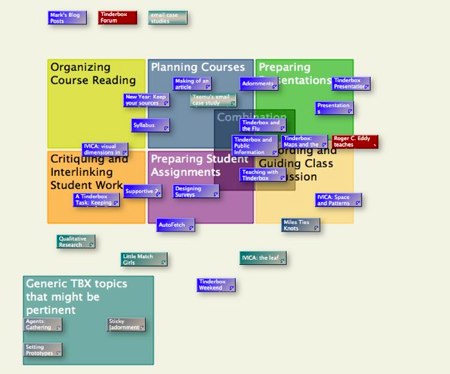Information Gardening
At the start of a new research project, you often need to dig in and gather lots of readily-available information, not to accumulate facts but to map out the structure of the domain you want to master.
A recent Tinderbox Forum discussion on Tinderbox & Teaching led new Eastgater Stacey Mason to cast around for resources in Tinderbox and its role in education. She gathered information from Google, from Eastgate’s office library, from a new agent in this weblog.
The query is Text(tbx)&Text(teaching|presentation|assignment|syllab|classroom). The agent took a minute to write, and it's miles better than toying with a whole sequence of searches. And now that I’ve made the agent, it’s right there, updating itself with new notes (like this one). And I can share it with you.
Naturally, Stacey kept notes in Tinderbox.
Notice the interesting way she uses adornments (including overlapping adornments) to organize the map. It’s easy to add notes, and easy to move them as our understanding changes. Adding a new category takes seconds; redefining an old category and redistributing its notes is just as fast. Unlike outliners and mind-maps and tag buckets, the tool doesn’t tempt you to retain your original organization by making big changes tedious and difficult. It’s easy to split categories, or to have notes that bridge areas, or to remind yourself that some categories might be provisional, flawed, or unrelated.
